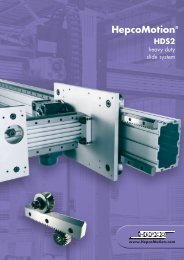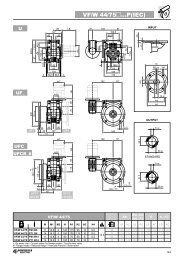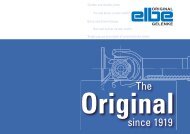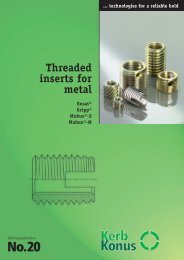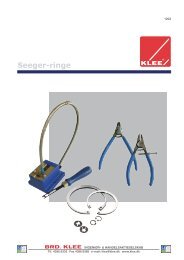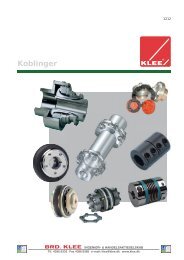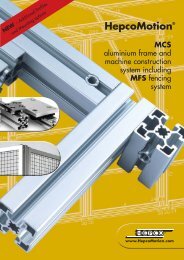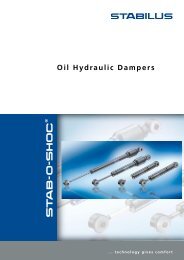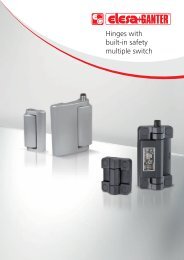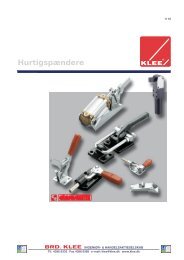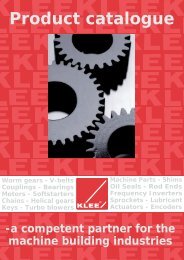LINEAR MOTION SOLUTIONS - Brd. Klee A/S
LINEAR MOTION SOLUTIONS - Brd. Klee A/S
LINEAR MOTION SOLUTIONS - Brd. Klee A/S
You also want an ePaper? Increase the reach of your titles
YUMPU automatically turns print PDFs into web optimized ePapers that Google loves.
Load Capacity<br />
Technical Information<br />
Technical Information<br />
LOAD CAPACITY (Pressure)<br />
Depending upon the material used, a plane bearing’s load<br />
capacity can greatly exceed a rolling element bearing. There<br />
are three basic reasons for this:<br />
1. The area of surface contact with the shaft is far greater than<br />
rolling element bearings, which have point-to-point contact<br />
with a given number of balls.<br />
2. A rolling element bearing must be oriented properly for<br />
the ball tracks to carry the load adequately, while a plane<br />
bearing can be mounted in any orientation.<br />
3. Only one or two of the tracks in a rolling element bearing<br />
will actually carry any of the load applied.<br />
Simplicity bearings have a thin liner that is bonded to a metal<br />
shell at the molecular level, allowing the load to be transferred<br />
throughout the bearing. This gives it an advantage over other<br />
plane bearings of solid plastic or polymer materials. These<br />
other materials will tend to “cold flow” under pressure. “Cold<br />
flow” means to deform or lose shape. The idea is similar to<br />
pressing your finger into a bar of soap - material will move or<br />
deform as pressure is applied.<br />
<strong>LINEAR</strong> SURFACE SPEEDS (Velocity)<br />
In typical applications, speed is a known quantity and easily<br />
converted. Typically feet per minute or meters per minute<br />
are used. The most important factor that speed (along with<br />
friction) produces is heat buildup. This is not a critical factor<br />
in most linear applications because the heat is dissipated<br />
over the length of travel, and it does not affect the bearing.<br />
Short stroke or extremely high speed applications may see the<br />
effects of heat buildup in thermal expansion and the bearing<br />
ID locking on the shaft. A compensated ID bearing (FLC) is<br />
recommended in these applications.<br />
FACTORS THAT CONTRIBUTE TO WEAR LIFE<br />
Proper mating of shaft and liner materials.<br />
Surface finish 8-16 RMS (.20-.40mm) is required. Peaks<br />
in the surface that are polished to a radius provide the best<br />
running surface. Sharp peaks in the finish will be like a fine<br />
lapping compound wearing the I.D. of the bearing.<br />
NOTE: Shafting damaged by use with ball bearings can be<br />
salvaged and used with Simplicity bearings. Spin in a lathe<br />
and polish with sand papers in this order: 120 grit, 180 grit,<br />
and 300 grit. This will also remove sharp peaks in the<br />
surface finish.<br />
Surface speed - at high speeds, heat buildup will affect<br />
liner wear.<br />
Break-in transfer - proper transfer process of the liner to the<br />
shaft. (pg. 46)<br />
Lubrication - proper lubrication can greatly improve the wear<br />
rate of a bearing. At the same time, improper lubrication can<br />
increase wear and failure.<br />
Load & Wear Relationship - Wear rate is proportional to load<br />
to the third power. (wear rate x (load) 3 .<br />
If load is reduced to 1/2, wear will be reduced to (1/2) 3 .<br />
Contamination - while migrating into the bearing and<br />
embedding into the liner, certain types of contamination may,<br />
over time, cause increased wear to the liner.<br />
NOTE: This is not an all inclusive list. There are many more<br />
factors within an application that can affect wear to different<br />
degrees. These are the major issues and the first things to<br />
address in a design.<br />
54<br />
800.962.8979 • www.pbclinear.com



